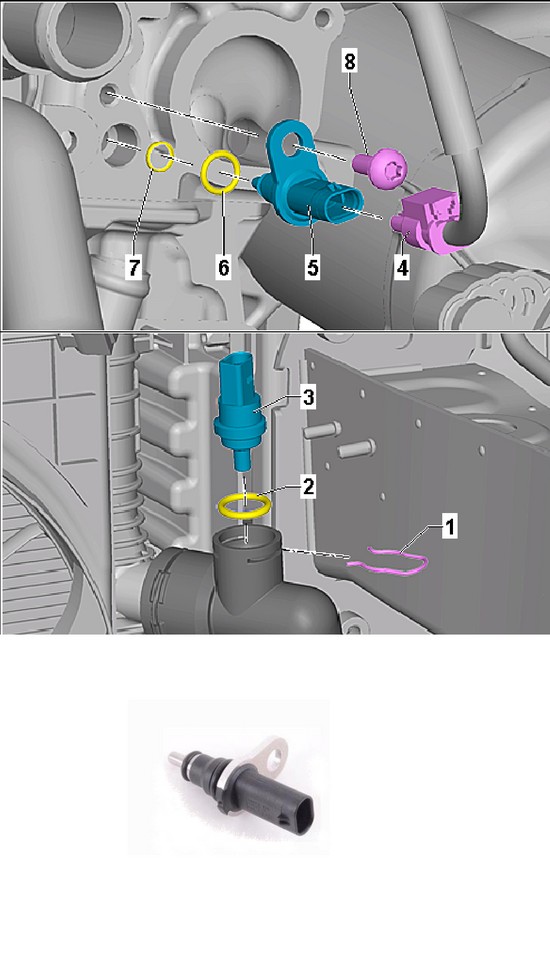A temperature sensor reading of -48°C on your car’s diagnostic scan can initially seem perplexing. As an automotive repair expert at keyfobprog.com, I’m here to clarify what this reading signifies, particularly in relation to your Engine Block Temperature Sensor, and guide you towards effective diagnostics. This article will delve into the workings of these sensors, interpret the -48°C value, and outline potential causes and troubleshooting steps.
Understanding Temperature Sensors: Negative Temperature Coefficient (NTC)
Engine temperature sensors, including those monitoring the engine block, predominantly utilize a technology known as Negative Temperature Coefficient (NTC). These sensors are ingeniously designed to translate temperature variations into electrical resistance changes. The core principle of an NTC sensor is that its resistance decreases as temperature increases, and conversely, its resistance increases as temperature drops.
Your vehicle’s Engine Control Unit (ECU), the sophisticated module often addressed as hex01 in diagnostic scans, is engineered to interpret these resistance fluctuations. A low resistance signal from the sensor is recognized by the ECU as a high engine temperature, while a high resistance signals a lower temperature. Crucially, these ECU circuits are calibrated with defined upper and lower temperature thresholds to ensure readings remain within plausible operating parameters.
Decoding -48°C: Indicating an Open Circuit
With the NTC sensor mechanism in mind, a -48°C reading is typically the lowest temperature value that the ECU is programmed to register. Due to the inherent NTC characteristic, this frigid reading actually points to an exceptionally high resistance within the temperature sensor circuit.
Diagnostically, a -48°C reading strongly suggests an “Open Circuit” condition. This means the electrical pathway is broken, preventing the flow of current. The issue could stem from several sources:
- Sensor Failure: The temperature sensor itself might have malfunctioned internally.
- Wiring Issues: Damage to the sensor wire, such as breaks or cuts, can disrupt the circuit.
- Connection Problems: A loose or corroded connection at either the sensor plug or the ECU connector can create an open circuit.
Common Engine Temperature Sensors: G62 and G83
The specific temperature sensors in your vehicle depend on the engine type. However, many modern engines employ two primary temperature sensors:
- Coolant Temperature Sender (G62): Typically located on the cylinder head, often near the gearbox end of the engine. This sensor is crucial for monitoring the engine coolant temperature for ECU calculations related to fuel injection, ignition timing, and cooling fan activation.
- Radiator Outlet Coolant Temperature Sender (G83): Usually found in the radiator outlet coolant hose. This sensor provides the ECU with information about the coolant temperature after it has passed through the radiator, aiding in cooling system efficiency monitoring.
While your diagnostic screenshot might hint at the presence of both G62 and G83 sensors in your engine, it’s imperative to verify your exact engine type from the complete diagnostic scan report. The engine type is usually detailed within the ECU information section of the report.
For example, the image below illustrates the placement of the G62 and G83 temperature sensors on a CJXC engine (2.0 liter, 4-valve, turbocharged, chain-drive, generation III engine):
 Location of coolant temperature sensors G62 and G83 on a CJXC engine, illustrating typical placement for engine temperature sensors.
Location of coolant temperature sensors G62 and G83 on a CJXC engine, illustrating typical placement for engine temperature sensors.
Diagnostic Steps for a -48°C Temperature Sensor Reading
When faced with a -48°C reading, a systematic diagnostic approach is essential:
- Visual Inspection: Begin by visually inspecting the temperature sensor and its wiring. Look for any obvious signs of damage to the sensor, frayed or broken wires, or loose connections at the sensor plug and ECU connector.
- Wiring Continuity Test: Use a multimeter to perform a continuity test on the sensor wiring. This will confirm if there is a break in the wire. Refer to your vehicle’s wiring diagram for the correct pins to test.
- Sensor Resistance Check: Disconnect the sensor and measure its resistance using a multimeter. Compare the reading to the sensor’s specifications at a known temperature (if available). An extremely high or infinite resistance reading often indicates a faulty sensor.
- ECU Connector Inspection: Examine the ECU connector pins for corrosion or damage. Clean any corrosion carefully.
- Scan Tool Data Verification: Re-scan the system after performing any repairs or checks to see if the -48°C reading persists or if the sensor reading now appears normal.
Conclusion
A -48°C reading from your engine block temperature sensor, or coolant temperature sensor, is a strong indicator of an open circuit within the sensor system. By understanding the function of NTC sensors and systematically diagnosing the sensor, wiring, and connections, you can effectively pinpoint the source of the problem and restore accurate temperature readings to your vehicle’s ECU. Always consult your vehicle’s repair manual for specific sensor locations and diagnostic procedures relevant to your engine type.
